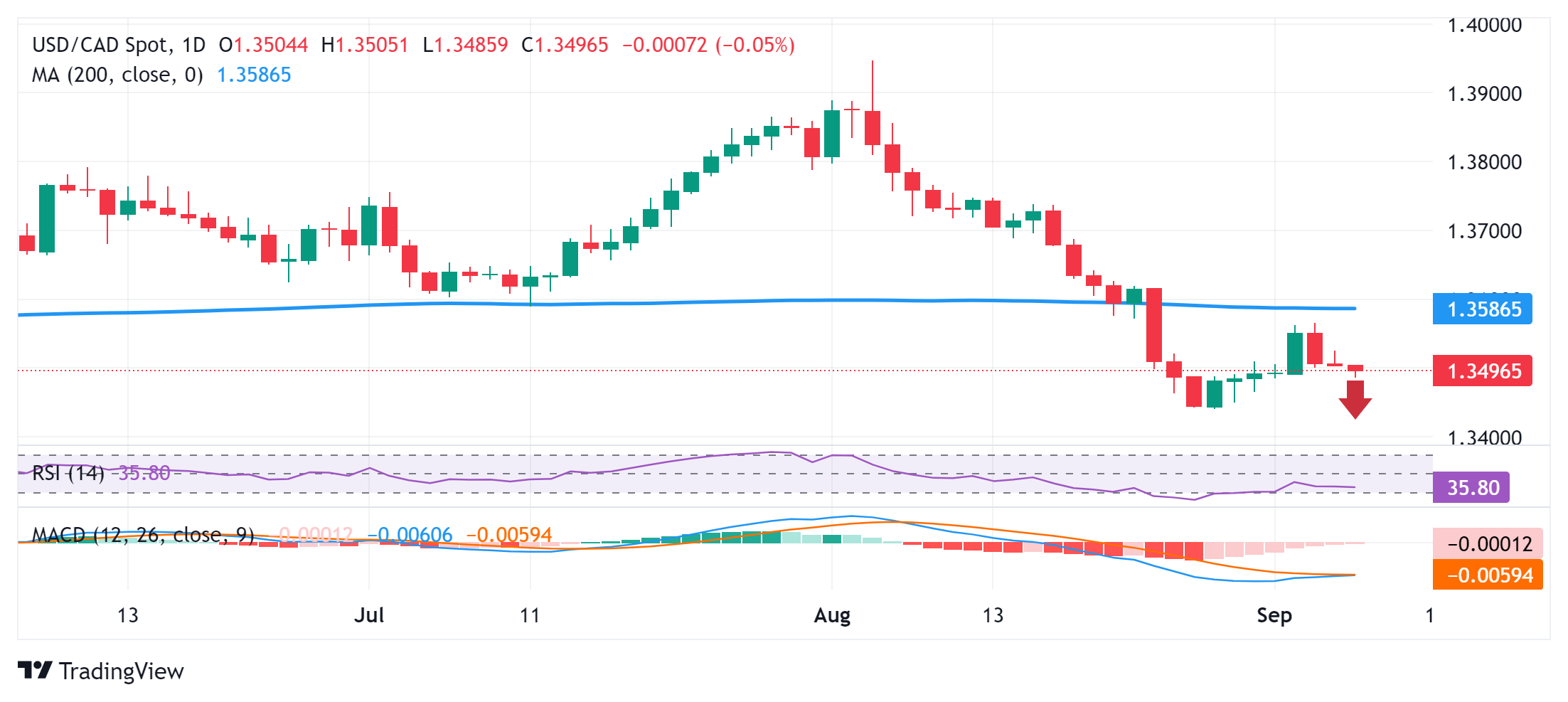- Phân tích
- Tin tức và các công cụ
- Tin tức thị trường
- USD/CAD Price Forecast: Hangs near weekly low, below 1.3500 ahead of US/Canadian jobs data
USD/CAD Price Forecast: Hangs near weekly low, below 1.3500 ahead of US/Canadian jobs data
- USD/CAD retests the weekly low on Friday and is pressured by a combination of factors.
- Fed rate cut bets weighs on the USD, while an uptick in Oil prices underpins the Loonie.
- The downside remains cushioned ahead of the monthly jobs data from the US and Canada.
The USD/CAD pair attracts sellers for the third straight day and remains depressed below the 1.3500 psychological mark, or the weekly low through the early European session on Friday.
The US Dollar (USD) selling bias remains unabated in the wake of bets for a larger interest rate cut by the Federal Reserve (Fed) in September. Apart from this, an uptick in Crude Oil prices is seen underpinning the commodity-linked Loonie and exerting downward pressure on the USD/CAD pair. The downside, however, seems limited as traders might opt to wait for the release of the crucial monthly employment details from the US and Canada, due later during the North American session.
From a technical perspective, the recent breakdown through the very important 200-day Simple Moving Average (SMA) was seen as a fresh trigger for bearish traders. Moreover, oscillators on the daily chart have recovered from the oversold zone and are still holding deep in negative territory. This suggests that the path of least resistance for the USD/CAD pair is to the downside and supports prospects for an extension of the slide from the 1.3565 area or a nearly two-week high touched on Wednesday.
Traders, however, need to wait for some follow-through selling below the 1.3485 region, or the weekly low, before positioning for any further losses. The USD/CAD pair might then accelerate the slide towards the multi-month trough, around the 1.3440 area touched last week before eventually dropping to the March monthly swing low, around the 1.3420 region. The downward trajectory could extend further towards the 1.3400 mark en route to the next relevant support near the 1.3365-1.3360 zone.
On the flip side, the overnight swing high, around the 1.3525 region, could cap any attempted recovery ahead of the 1.3565 area, or the weekly peak. The subsequent move up has the potential to lift the USD/CAD pair back towards the 200-day SMA support breakpoint, now turned resistance, currently pegged near the 1.3590 zone. A sustained strength beyond the latter could negate the near-term negative bias and trigger a short-covering rally towards the 1.3640-1.3645 resistance.
USD/CAD daily chart
Economic Indicator
Unemployment Rate
The Unemployment Rate, released by Statistics Canada, is the number of unemployed workers divided by the total civilian labor force as a percentage. It is a leading indicator for the Canadian Economy. If the rate is up, it indicates a lack of expansion within the Canadian labor market and a weakening of the Canadian economy. Generally, a decrease of the figure is seen as bullish for the Canadian Dollar (CAD), while an increase is seen as bearish.
Read more.Next release: Fri Sep 06, 2024 12:30
Frequency: Monthly
Consensus: 6.5%
Previous: 6.4%
Source: Statistics Canada
© 2000-2025. Bản quyền Teletrade.
Trang web này được quản lý bởi Teletrade D.J. LLC 2351 LLC 2022 (Euro House, Richmond Hill Road, Kingstown, VC0100, St. Vincent and the Grenadines).
Thông tin trên trang web không phải là cơ sở để đưa ra quyết định đầu tư và chỉ được cung cấp cho mục đích làm quen.
Giao dịch trên thị trường tài chính (đặc biệt là giao dịch sử dụng các công cụ biên) mở ra những cơ hội lớn và tạo điều kiện cho các nhà đầu tư sẵn sàng mạo hiểm để thu lợi nhuận, tuy nhiên nó mang trong mình nguy cơ rủi ro khá cao. Chính vì vậy trước khi tiến hành giao dịch cần phải xem xét mọi mặt vấn đề chấp nhận tiến hành giao dịch cụ thể xét theo quan điểm của nguồn lực tài chính sẵn có và mức độ am hiểu thị trường tài chính.
Sử dụng thông tin: sử dụng toàn bộ hay riêng biệt các dữ liệu trên trang web của công ty TeleTrade như một nguồn cung cấp thông tin nhất định. Việc sử dụng tư liệu từ trang web cần kèm theo liên kết đến trang teletrade.vn. Việc tự động thu thập số liệu cũng như thông tin từ trang web TeleTrade đều không được phép.
Xin vui lòng liên hệ với pr@teletrade.global nếu có câu hỏi.
















